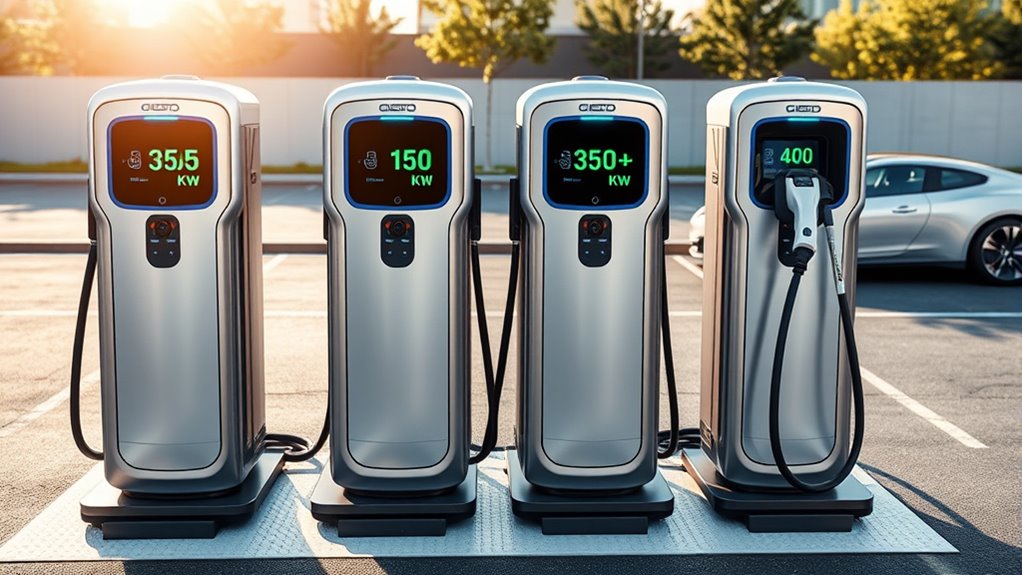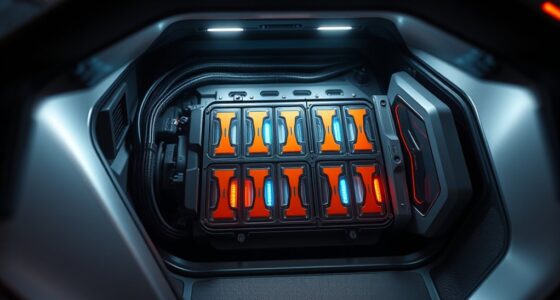Charging infrastructure ratings like 150 kW, 350 kW, and 400 kW and beyond help you gauge how fast and reliable stations are. Faster chargers, like 350 kW and above, recharge your vehicle much quicker, perfect for long trips or quick stops. Coverage varies, so checking these ratings guarantees you’ll find stations that meet your travel needs. Keep exploring to discover how these ratings can help you choose the best charging options for your journey.
Key Takeaways
- Higher kilowatt ratings (e.g., 350 kW, 400 kW) enable faster charging times compared to lower ratings like 150 kW.
- Charging stations with ratings beyond 400 kW are emerging to support ultra-fast charging needs for long-distance travel.
- Ratings indicate the maximum power output; actual charging speeds depend on vehicle compatibility and battery acceptance rate.
- Infrastructure with higher kW ratings often require advanced hardware and grid capacity to deliver optimal performance.
- Balancing charger power ratings with network coverage ensures accessible, reliable ultra-fast charging across regions.

Charging infrastructure ratings provide a clear way to evaluate the quality and reliability of electric vehicle charging stations. When evaluating these ratings, two key factors stand out: charger speed and network coverage. Charger speed refers to how quickly the station can replenish your vehicle’s battery, directly impacting your travel plans. A fast charger, often rated at 50 kW or higher, can give you a substantial charge in just minutes, making long trips more feasible. Conversely, slower chargers might take hours to fully recharge, which can be inconvenient if your schedule demands quick turnarounds. As such, understanding the charger speed at a station helps you decide if it aligns with your driving needs and time constraints.
Network coverage is equally critical. It determines how widespread and accessible the charging stations are across regions. A robust network ensures you can reliably find a station when you need it, reducing range anxiety. When ratings emphasize network coverage, they highlight whether the charging stations are concentrated in urban areas or spread out across highways and rural routes. A complete network allows you to plan longer journeys with confidence, knowing that charging options are readily available along your route. If a station has excellent charger speed but limited network coverage, you might find yourself stranded without a nearby charging point. Conversely, a widespread network with slower chargers may still meet your needs if you have ample time to recharge.
In evaluating charging infrastructure ratings, it’s crucial to balance charger speed with network coverage. A fast charger is beneficial, but only if it’s accessible when you need it. Conversely, extensive network coverage is valuable, but if the stations are slow, you might still face delays. The ideal setup combines high charger speeds with extensive network coverage, ensuring you can quickly and reliably recharge wherever you go. When using ratings to choose charging stations, look for those with high scores in both areas. This way, you’re more likely to find a station that matches your driving style and travel plans, giving you peace of mind on the road. Additionally, considering the retention of nutrients in vegetable juices can help optimize your health as you plan your trips and routines, ensuring you stay energized and well-nourished. Ultimately, understanding these factors helps you make smarter decisions about where and when to charge, improving your electric vehicle experience and keeping you moving efficiently.
Frequently Asked Questions
How Do Charging Ratings Affect Vehicle Charging Times?
Charging ratings directly impact your vehicle’s charging time by determining the charging speed and energy transfer rate. Higher ratings mean faster energy transfer, so your car charges more quickly. For example, a higher kilowatt (kW) rating allows more power to flow into your battery, reducing your wait time. Conversely, lower ratings transfer energy more slowly, extending charging times. Selecting infrastructure with appropriate ratings guarantees you get efficient, faster charging suited to your needs.
What Are the Differences Between AC and DC Charging Ratings?
Imagine charging your phone with a fast charger versus a regular one. AC charging uses your car’s onboard charger to convert AC power from the plug into DC, which then charges the battery slowly. DC fast charging bypasses this, delivering high power directly to the battery through specialized charging plugs, enabling rapid charging. The key difference lies in power conversion speed and the types of charging plugs used, impacting how quickly you can recharge your EV.
Can Higher Kw Ratings Damage My Electric Vehicle?
Higher kW ratings won’t damage your electric vehicle if the charging station is compatible with your car’s battery system. In fact, fast charging can help maintain your battery’s longevity when used appropriately. Just make sure to use stations designed for your vehicle, as incompatible chargers might cause stress on the battery, potentially reducing its lifespan. Always follow your manufacturer’s recommendations for best charging to keep your EV in good shape.
How Are Charging Infrastructure Ratings Standardized Internationally?
You’ll find that international standards for charging infrastructure ratings are mainly guided by regulatory standards, guaranteeing consistency across regions. These standards use measurement units like kilowatts (kW) to indicate charging power. This way, you can compare chargers easily, regardless of where you are. Manufacturers and authorities follow these standards to ensure safety, compatibility, and performance, making your EV charging experience more reliable and straightforward worldwide.
What Future Developments Might Increase Charging Capacity Beyond Current Ratings?
You might see charging capacities double or even triple in the next decade. Innovations like wireless charging could enable vehicles to recharge without plugging in, while advanced battery thermal management guarantees safety and efficiency during rapid charging. These developments will push infrastructure ratings beyond current limits, making charging faster, more convenient, and suitable for high-capacity needs. Prepare for a future where charging stations can handle even the most demanding electric vehicles effortlessly.
Conclusion
So, as you race to upgrade your charging stations to 150 kW, 350 kW, or even beyond, it’s amusing how speed becomes the real priority. You might think higher ratings mean better efficiency, but often it’s just a race to stay ahead of the next station. In the end, faster isn’t always smarter—you’re just chasing a number, not necessarily a smarter charge. Irony, isn’t it? The faster you go, the more you realize the journey isn’t just about speed.









